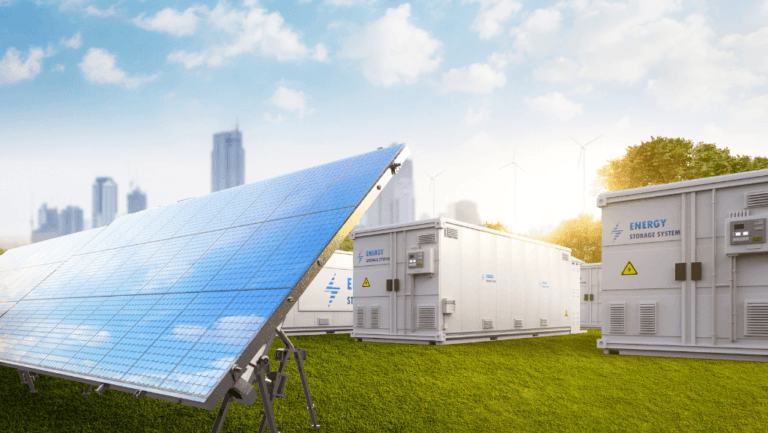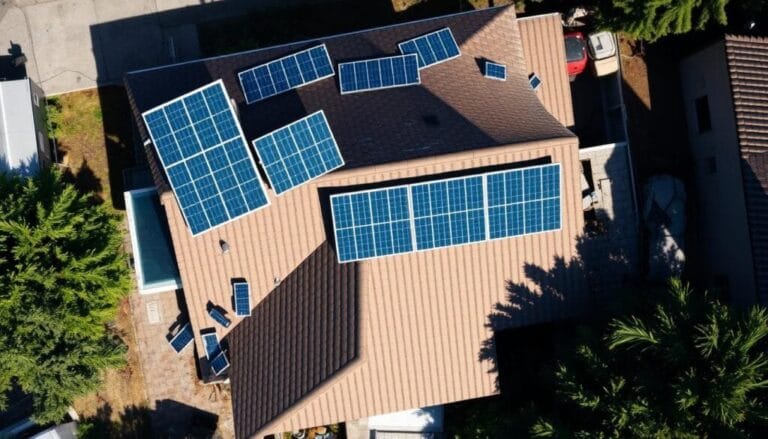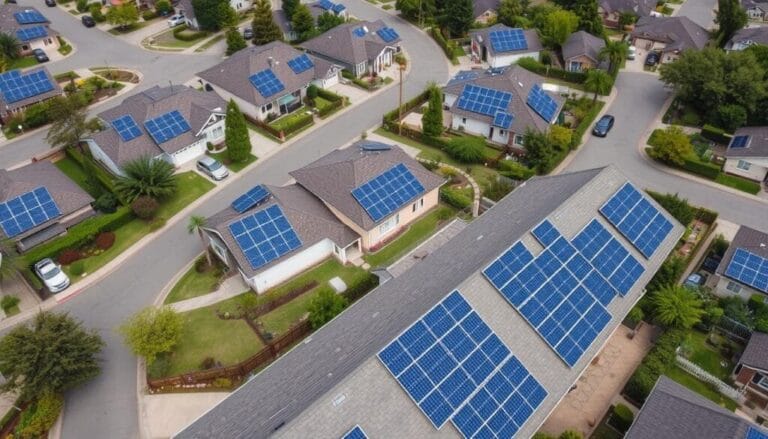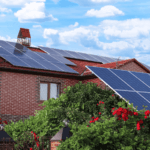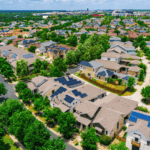Starting to explore solar power systems leads us to a key question: Is solar DC or AC? This question is crucial for understanding how solar systems work and how they fit into our daily lives. Solar panels are key to this energy shift, making a solar panels comparison vital to see their role in sustainable power.
Solar panels turn sunlight into electricity, offering more than just an alternative energy source. This process, from the photovoltaic effect to modern inverter technology, changes sunlight into the alternating current (AC) we use at home and work. The design of solar panels, which naturally produces direct current (DC), shows the challenge of fitting this power into our AC-based world. This highlights the blend of solar production and energy use.
The shift from DC to AC is central to solar technology today. Companies like Freyr Energy offer solutions that use both DC’s benefits and AC’s wide use. This shows the importance of understanding how solar power moves from production to use.
Key Takeaways
- Knowing the difference between AC and DC power is key to understanding solar power systems.
- AC is versatile and safe, making it the norm in homes and businesses.
- Solar panels make DC power, which needs inverters to be used in most places.
- Companies like Freyr Energy offer both AC and DC solar solutions for different needs.
- Modern solar solutions use both AC and DC to improve efficiency and usefulness.
- Old debates, like Edison and Tesla’s “War of the Currents,” show the long history of AC and DC in energy.
The Fundamentals of Solar Power Systems
The process of turning sunlight into electricity is a complex feat of modern engineering. It involves converting light into electricity, mainly through solar panels that produce direct current (DC). Knowing the difference between direct current vs alternating current, the types of solar inverters, and the solar panel output is key to making these systems work well for homes and businesses.
Direct Current vs Alternating Current in Solar Technology
Solar panels make electricity in DC, which moves in one direction. But most home devices and the power grid use alternating current (AC), which changes direction. This means we need to change DC to AC, which is where solar inverters come in. This change loses about 3% to 5% of energy, showing why picking the right inverter is so important.
The Role of Solar Inverters in Energy Conversion
Inverters are essential for solar power systems, turning DC from panels into AC for use at home or on the grid. There are several types of solar inverters, like string, microinverters, and hybrid inverters, each suited for different solar setups. Microinverters work well for single panels, while string inverters are better for big setups. Newer inverters also have smart features that adjust power based on energy needs and production levels, making them more efficient.
Solar Panels Comparison: Output Variations
The solar panel output is key to how well a solar power system meets needs. Panels promise at least 80% efficiency for 25 years, making them a good choice. They produce DC, and with MPPT technology, controllers can improve this output for better system efficiency. It’s important to understand these aspects for anyone looking into solar energy.
Understanding direct current vs alternating current, the roles of solar inverter types, and solar panel output helps people make smart choices. These choices can boost their investment and help the planet. Using these components well is what makes solar power systems reliable in homes and businesses.
Historical Battle: AC vs. DC and Its Impact on Solar
The battle between AC (Alternating Current) and DC (Direct Current) changed the way we use electricity, including solar energy. This fight, led by Thomas Edison and Nikola Tesla, shaped our electrical systems. It also influenced the growth of energy technology.
Edison vs. Tesla: The War of the Currents
In the late 19th century, Edison and Tesla clashed over electricity. Edison supported DC, but Tesla believed in AC for its efficiency in long-distance transmission. The debate reached a peak at the Chicago World’s Fair, where Tesla’s AC lit the fair more cheaply than Edison’s DC.
The Transition from DC to AC Dominance
After the Chicago World’s Fair, AC became the leading choice for power. Westinghouse introduced high-voltage AC systems in 1886. By the 1890s, AC lit cities like Buffalo from Niagara Falls, making it the top choice for power.
The last DC utility in New York City closed in 2007. This marked the end of DC’s use in power distribution.
Modern Applications of DC in Solar Energy Solutions
Even though AC is common, DC is vital in solar energy. Solar panels produce DC, which is then turned to AC for use. DC is also key for solar batteries and electric vehicles.
Now, companies are working on high voltage direct current (HVDC) for long-distance power. This technology helps connect traditional and renewable energy sources.
Is Solar DC or AC?
Many people wonder: is solar DC or AC when talking about solar panels and making electricity? First off, solar panels make Direct Current (DC) electricity. This is because the process of turning sunlight into electricity moves in one steady direction. This method is key for getting the most solar energy.
But, for us to use this energy at home and connect it to the power grid, it must change to Alternating Current (AC). AC is better for many appliances and lets electricity travel long distances safely and efficiently. An inverter changes DC to AC, which is crucial for this.
DC solar setups are best for small, off-grid uses that need simple power solutions. They work great with battery storage because they like steady voltage. On the other hand, AC systems are key for adding solar power to the big grid. They handle big power needs and long-distance transmission well.
To wrap it up, even though solar panels make DC, most systems turn it into AC for everyday use. This flexibility in changing current types makes solar energy a top choice for today’s energy needs. It connects technology with our everyday energy use.
Grid-Tied Solar Systems and Their Dependency on AC Power
Grid-tied solar systems are key to modern renewable energy. They use alternating current (AC) power well. These systems help homeowners and businesses save on energy costs and protect the environment.
Understanding How Solar Energy Integrates with the Public Grid
Grid-tied solar systems make it easy to add solar energy to the public grid. They use net metering to balance energy use. This means you can use solar power during the day to pay for power at night or when it’s cloudy.
This balance helps keep energy costs stable. It also means you always have power without needing big batteries. In 39 states, net metering rules make using solar energy even more attractive.
Inverter Types: String vs. Microinverters
The type of inverter used affects how well grid-tied systems work. There are two main types: string and microinverters. String inverters work for a group of panels and are cheaper but less flexible. Microinverters work on each panel, giving better performance even with shadows or dirt.
Benefits of Grid-Tied Systems for Home and Business
Grid-tied solar systems offer many benefits. They are cheaper than off-grid systems because you don’t need big batteries. They also help the environment by sending extra power back to the grid.
Some places let owners make money by selling Solar Renewable Energy Credits (SRECs). These credits come from making more clean energy than you use.
Grid-tied solar systems show how modern solar tech is efficient, cost-effective, and good for the planet. They help homes and businesses use energy better and support a sustainable future.
Exploring Off-Grid Solar Setups: A DC Domain
Off-grid solar setups change how we use energy, especially in places far from the main power grid. They use solar panels and work with DC power. This setup stores power in batteries and uses appliances that run on DC, cutting down on energy loss.
For those wanting energy freedom, off-grid solar setups are a great choice. They’re key in places with poor grid service and are getting popular for being green and saving money. Knowing the basics—solar panels, charge controller, batteries, and inverter—is key for anyone looking into this.
Getting off-grid solar setups right depends on quality parts for reliable power. Brands like Kangweisi lead the way with advanced solar solutions that fit well with off-grid systems. Their systems use MPPT technology to boost solar power efficiency.
The cost of off-grid systems varies with energy needs. The initial cost is high, from $20,000 to $32,000 for a home system. But, the long-term savings and benefits make it worth it. These systems are about more than just power; they’re about being sustainable and resilient. They provide steady energy in remote places, cut down on greenhouse gases, and reduce fossil fuel use.
| Component | Function | Brand |
|---|---|---|
| Solar Panels | Capture sunlight and convert it into DC electricity | Kangweisi |
| Battery Storage | Stores electricity for use when sunlight is not available | Kangweisi |
| Inverter Charger | Converts DC electricity into AC for household use | Kangweisi |
| Charge Controller | Manages power going into the batteries to avoid overcharging | Kangweisi |
Renogy’s guide on solar power systems offers deep insights on setting up and optimizing off-grid setups. Discussions on solar energy’s pros and cons help users make smart choices.
Understanding these systems and new solar technologies helps people make better choices. It’s about meeting energy needs and helping the environment. With technological, economic, and sustainability factors in mind, off-grid solar setups are becoming a top choice for eco-friendly living.
Solar Inverter Types: String Inverters, Microinverters and Power Optimizers
Knowing about solar inverter types is key to making your solar power system work better and save money. Each inverter type—string inverters, microinverters, and power optimizers—has its own benefits for different setups.
Distinguishing Between Inverter Technologies
String inverters are a budget-friendly choice, perfect for places that get lots of sun and have simple roof setups. Microinverters are great for tricky setups like roofs with many angles or shadows, letting each panel work at its best. Power optimizers sit between these two, boosting each panel’s power before sending it to a central inverter.
Brands like Enphase for microinverters and SolarEdge for string and DC optimizers are well-known. They offer 25-year warranties, making them reliable for a long time. Microinverters and power optimizers usually have longer warranties than string inverters.
How Inverters Influence Solar Power Systems Efficiency
Microinverters and power optimizers make solar power systems more efficient by letting each panel work on its own. This means less energy loss from shadows or dirt. They also let you check how each panel is doing, making upkeep and energy use easier.
Studies show microinverters can capture 5-20% more energy than old string systems over time. Their safety features and efficiency make them a top pick, even if they cost more at first.
Cost Considerations in Solar Inverter Selection
Microinverters are pricier but offer great performance and safety. String inverters are cheaper but work best for simple setups. Power optimizers are a good middle option, costing less than microinverters but offering similar benefits.
It’s smart to talk with installers to find the best inverter for your setup. They can help balance the upfront cost with long-term energy savings.
For more on how new tech has boosted solar panel efficiency, check out our guide on modern solar tech.
Advantages of DC in Solar Power Generation
Exploring DC in solar power shows many benefits, like better efficiency and safety. Solar energy fits well with DC, making it great for using with devices and storage systems. This part looks at how DC-coupled systems are changing renewable energy, especially in solar power.
Higher Efficiency in DC-Coupled Solar Storage Systems
DC in solar is key in DC-coupled systems for better efficiency. These systems don’t need as many conversions as AC systems do. This means less energy loss and more efficient use of power. Studies show DC-coupled systems are more efficient, with fewer conversions and less waste.
Safety and Voltage Considerations with Direct Current
DC systems are safer than AC ones because they have lower voltage risks. This is important for homes and businesses, making them safer and reducing electrocution risks. Also, DC doesn’t lose much power over short distances, making it ideal for local solar use. This boosts safety and energy efficiency.
DC’s Compatibility with Electronic Devices and EVs
DC works well with electronic devices, which is great for our tech-filled lives. Most gadgets, like phones, laptops, and EVs, run better on DC. Using DC-coupled batteries means no extra conversions when charging these devices. This makes solar tech easier to use, saving money and energy.
DC in solar power is a strong choice for today’s energy needs. It also opens doors for future solar tech improvements.
AC vs. DC Solar Panels: A Comprehensive Analysis
Understanding the differences between AC and DC solar panels is key for both consumers and professionals. This look into the technical aspects, costs, and efficiency will help pick the best option for different needs.
AC solar panels use microinverters to change DC to AC right where they are installed. This makes them easier to set up and work well with the power grid. The comparison shows DC panels are cheaper but work better with DC storage systems.
- Integration with Microinverters: Microinverters are crucial in AC panels. They make solar systems more flexible and let each panel work on its own. This boosts performance and keeps the system running smoothly.
- Cost and Efficiency: DC systems start cheaper but AC systems have long-term benefits. They are more reliable and have a backup system, thanks to two inverters.
When it comes to efficiency, AC vs. DC solar panels take different paths. DC systems lose less energy because they don’t need to change power types as much. This makes them more efficient, especially when used with batteries for a smooth flow of power.
- Ease of Installation: AC systems are better for adding to existing solar setups because they’re easy to connect.
- Energy Resilience: AC systems have two inverters that keep important loads running during power cuts. This is a big plus in areas with a stable power grid.
- System Design: DC setups use one inverter to link panels and batteries. This makes the setup simpler but limits how the system can grow or change.
It’s also important to think about where you’ll install the system. AC is great for areas with a stable power grid, while DC is better for places without reliable power. When choosing between solar panels, consider microinverters, system design, costs, and upkeep to get the most from your investment and keep producing clean energy.
Looking into these systems more can help you make a smart choice. Resources like AC vs. DC-coupled solar power systems offer detailed info and stats. This can guide you in picking the right solar technology for your needs.
Conclusion
The debate between direct current vs alternating current has been key in solar energy’s story. It shows how these two currents have shaped the past and will shape the future of solar tech. Solar panels make DC power, but our homes and grids use AC. This difference led to the creation of different inverters and solar batteries, each with its own benefits.
When adding solar batteries to systems, AC-coupled setups are popular with homeowners. But, they lose some efficiency because of the need for extra conversions. On the other hand, DC systems are more efficient and cost-effective, needing only one conversion. The differences between AC and DC help create solar solutions that meet various needs while being eco-friendly.
Understanding these concepts is key to using solar energy well. With DC-coupled systems and future tech like HVDC transmission, solar power could greatly reduce electricity bills and increase energy independence. When picking a solar inverter from brands like SolarEdge, Enphase, or Tesla, the aim is to make solar panels work best with our power systems. This ensures we use every sunbeam efficiently for a greener future.







